Saturday (day 3) : Akropolis Museum - Keramikos - Kentriki Agora - El. Venizelou
Saturday 24 March
After an early breakfast at 8am, we set out to visit the 'Theatro Dionissiou' (lower part of the Acropolis) and the new museum.

 We first paid a visit to the small Orthodox church Agios Dimitrios,
We first paid a visit to the small Orthodox church Agios Dimitrios,
in front of our hotel.
 Our walk took us (again) along the Hadrian Library, the Roman Agora and the Plaka, after which we took the climbing small streets, which Mieke and I took in the opposite direction Friday morning.
Our walk took us (again) along the Hadrian Library, the Roman Agora and the Plaka, after which we took the climbing small streets, which Mieke and I took in the opposite direction Friday morning.






 From there we walked (again) to the Odeon, which we saw from a different angle this time.
From there we walked (again) to the Odeon, which we saw from a different angle this time.


In 1833, the Turkish garrison withdrew from the Acropolis. Immediately after the founding of the Greek State, discussions about the construction of an Acropolis Museum on the Hill of the Acropolis began. In 1863, it was decided that the Museum be constructed on a site to the southeast of the Parthenon and foundations were laid on 30 December 1865.
 Today, the new Acropolis Museum has a total area of
25,000 square meters, with exhibition space of over 14,000 square meters, ten
times more than that of the old museum on the Hill of the Acropolis. The new
Museum offers all the amenities expected in an international museum of the 21st
century.
Today, the new Acropolis Museum has a total area of
25,000 square meters, with exhibition space of over 14,000 square meters, ten
times more than that of the old museum on the Hill of the Acropolis. The new
Museum offers all the amenities expected in an international museum of the 21st
century.








 With its Roman arches and three story stage building, it was originally partly covered with a wood and tiled roof. The circular orchestra has now become a semi-circle, paved with black and white marble. With 35 rows, the marble auditorium extends slightly beyond a semi-circle with a diameter of 80 metres and today seats 4680 people.
With its Roman arches and three story stage building, it was originally partly covered with a wood and tiled roof. The circular orchestra has now become a semi-circle, paved with black and white marble. With 35 rows, the marble auditorium extends slightly beyond a semi-circle with a diameter of 80 metres and today seats 4680 people.

 In the first room the visitor will see the tombstones that adorned the cemetery. The older ones belong to the Archaic period (9th -7th century B.C.) and the newest ones to the Roman period. In these grave stones the development of the sculptural style and the technique of the relief are obvious. The interior yard also contains sculptures and scriptures on stone from the cemetery.
In the first room the visitor will see the tombstones that adorned the cemetery. The older ones belong to the Archaic period (9th -7th century B.C.) and the newest ones to the Roman period. In these grave stones the development of the sculptural style and the technique of the relief are obvious. The interior yard also contains sculptures and scriptures on stone from the cemetery.

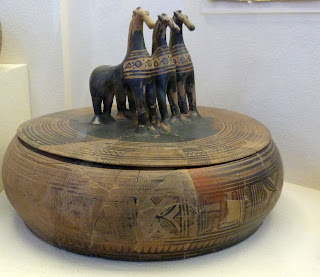 The following rooms have vases, jewelry and other objects that were offered as kterismata (objects that supposedly accompanied the dead to his afterlife).
The following rooms have vases, jewelry and other objects that were offered as kterismata (objects that supposedly accompanied the dead to his afterlife).


 A small part of the Sacred road leading from the suburbs to the Sacred Rock of Acropolis can also be seen here. Next to the road there is the canal where the ancient river Iridanos flowed. Outside the city walls, on the site of Keramikos was the city's cemetery. The ancient Athenians had built a square at the edge of the cemetery. There, rituals and sport events were organized in honor of the dead.
A small part of the Sacred road leading from the suburbs to the Sacred Rock of Acropolis can also be seen here. Next to the road there is the canal where the ancient river Iridanos flowed. Outside the city walls, on the site of Keramikos was the city's cemetery. The ancient Athenians had built a square at the edge of the cemetery. There, rituals and sport events were organized in honor of the dead.

 We paid a visit to Technopolis in the Gazi area.
We paid a visit to Technopolis in the Gazi area.
Technopolis is a great example of a renovation of an old factory to a cultural venue.
The complex used to host the gas factory of Athens - that's wat the Gazi area owes its name to.
When electricity became the one and only source of energy, the factory was abandoned.


For our evening walk, we visited the Central Market, and from there we walked to the famous
Venizelou Eleftheriou street(also called Panepistimiou), where many beautiful official buildings are situated.











After an early breakfast at 8am, we set out to visit the 'Theatro Dionissiou' (lower part of the Acropolis) and the new museum.

 We first paid a visit to the small Orthodox church Agios Dimitrios,
We first paid a visit to the small Orthodox church Agios Dimitrios,in front of our hotel.
 Our walk took us (again) along the Hadrian Library, the Roman Agora and the Plaka, after which we took the climbing small streets, which Mieke and I took in the opposite direction Friday morning.
Our walk took us (again) along the Hadrian Library, the Roman Agora and the Plaka, after which we took the climbing small streets, which Mieke and I took in the opposite direction Friday morning.



The theatre was built at the time when 'drama' or 'theatre' was first being created. It's thought that the first drama was presented by Thespis in about 530 BC (which is where we get the word 'Thespian'). These dramas were probably performed in the Agora.
The cult of Dionysus was brought to Athens in the 6th C BC, and the threatre was built as part of the temple precinct.
In the 5th C BC major works of theatre were performed. These plays were written by some of the great "Attic tragedians", men such as Aeschylus, Sophocles and Euripides. The plays were performed as part of the cult celebrations of Dionysus. Fortunately, many of their plays have survived, which give us a unique insight into their thinking.


 From there we walked (again) to the Odeon, which we saw from a different angle this time.
From there we walked (again) to the Odeon, which we saw from a different angle this time.

The actual Acropolis Museum was
firstly conceived by Constantinos Karamanlis in September 1976. He also
selected the site, upon which the Museum was finally built, decades later.
In 1989, Melina Mercouri, who as Minister of Culture
inextricably identified her policies with the claim for the return of the
Parthenon Marbles from the British Museum, initiated an international
architectural competition.
In the year 2000, the Organization for the
Construction of the New Acropolis Museum announced an invitation to a new
tender, which was realized in accord with the Directives of the European Union.
It is this Tender that has come to fruition with the awarding of the design
tender to Bernard Tschumi with Michael Photiadis and their associates and the
completion of construction in 2007.
 Today, the new Acropolis Museum has a total area of
25,000 square meters, with exhibition space of over 14,000 square meters, ten
times more than that of the old museum on the Hill of the Acropolis. The new
Museum offers all the amenities expected in an international museum of the 21st
century.
Today, the new Acropolis Museum has a total area of
25,000 square meters, with exhibition space of over 14,000 square meters, ten
times more than that of the old museum on the Hill of the Acropolis. The new
Museum offers all the amenities expected in an international museum of the 21st
century.







On our walk back along the Dionissiou Areopagitou (again) we had our last view of Herodes Atticus' Odeon (Odeio Irodiou Attikou) from the public entrance.
Widely known by locals as simply “Herodeon”, it was built between 160AD – 174AD by the wealthy benefactor of Athens, Herodes Atticus as an ode to his late wife Rigilla. It was the third Odeon to be built in Athens and was distinctively Roman in contrast to the nearby Theatre of Dionysos.
 With its Roman arches and three story stage building, it was originally partly covered with a wood and tiled roof. The circular orchestra has now become a semi-circle, paved with black and white marble. With 35 rows, the marble auditorium extends slightly beyond a semi-circle with a diameter of 80 metres and today seats 4680 people.
With its Roman arches and three story stage building, it was originally partly covered with a wood and tiled roof. The circular orchestra has now become a semi-circle, paved with black and white marble. With 35 rows, the marble auditorium extends slightly beyond a semi-circle with a diameter of 80 metres and today seats 4680 people.
 |
| The museum of Keramikos is situated in the archaeological site of Keramikos. The museum holds the findings of the archaeological site. |
 In the first room the visitor will see the tombstones that adorned the cemetery. The older ones belong to the Archaic period (9th -7th century B.C.) and the newest ones to the Roman period. In these grave stones the development of the sculptural style and the technique of the relief are obvious. The interior yard also contains sculptures and scriptures on stone from the cemetery.
In the first room the visitor will see the tombstones that adorned the cemetery. The older ones belong to the Archaic period (9th -7th century B.C.) and the newest ones to the Roman period. In these grave stones the development of the sculptural style and the technique of the relief are obvious. The interior yard also contains sculptures and scriptures on stone from the cemetery.
 The following rooms have vases, jewelry and other objects that were offered as kterismata (objects that supposedly accompanied the dead to his afterlife).
The following rooms have vases, jewelry and other objects that were offered as kterismata (objects that supposedly accompanied the dead to his afterlife).  |
| Stele of Demetria and Pamphile |


The last room has artifacts that were discovered in a group tomb of men, women and children. It seems that in the 429-426 a malady infested Athens killing a substantial number of the population. The authorities gathered the bodies of the dead and buried them hastily in a group tomb so that the living would not be contaminated.
At the site of Keramikos one can see the walls of the ancient city of Athens and the main monumental gate to the town. The entrance to the city had at both sides two big towers that were used for protection against hostile armies.
 A small part of the Sacred road leading from the suburbs to the Sacred Rock of Acropolis can also be seen here. Next to the road there is the canal where the ancient river Iridanos flowed. Outside the city walls, on the site of Keramikos was the city's cemetery. The ancient Athenians had built a square at the edge of the cemetery. There, rituals and sport events were organized in honor of the dead.
A small part of the Sacred road leading from the suburbs to the Sacred Rock of Acropolis can also be seen here. Next to the road there is the canal where the ancient river Iridanos flowed. Outside the city walls, on the site of Keramikos was the city's cemetery. The ancient Athenians had built a square at the edge of the cemetery. There, rituals and sport events were organized in honor of the dead. |
| These grave-markers were commonly used after a law was passed prohibiting the more elaborate monuments, (with statues, for example) which had previously been in vogue. |

 We paid a visit to Technopolis in the Gazi area.
We paid a visit to Technopolis in the Gazi area.Technopolis is a great example of a renovation of an old factory to a cultural venue.
The complex used to host the gas factory of Athens - that's wat the Gazi area owes its name to.
When electricity became the one and only source of energy, the factory was abandoned.
 After 1999, the gas factory was restored and became the Industrial Gas Museum and a cultural center, a fact that led to the development of the surrounding area as well. Today, Technopolis is a site that hosts many cultural activities of all kinds.
After 1999, the gas factory was restored and became the Industrial Gas Museum and a cultural center, a fact that led to the development of the surrounding area as well. Today, Technopolis is a site that hosts many cultural activities of all kinds.


For our evening walk, we visited the Central Market, and from there we walked to the famous
Venizelou Eleftheriou street(also called Panepistimiou), where many beautiful official buildings are situated.
 |
| Kentriki Agora (Central Market) |




 |
| The National Library (Ethniki Vivliothiki) |
Its official name is Eleftheriou Venizelou, but all Athenians know it as Panepistimiou (University) street. It was one of the first avenues to be laid out when Athens was being transformed into a modern capital during the reign of King Otto. The Academy of Athens, the National and Kapodistrian University of Athens and the National Library are considered the three architectural jewels of the city center. A hymn to neoclassicism, the three buildings gave Athens the air of a major European city. But there are many more impressive buildings to catch the attention of architecture lovers.



 |
| Agios Dionissios |


Evening drinks in the elegant
City Link Passage
 |
| Fabulous dinner in Oineaz (we ordered a beautiful variety of Appetizers) |


























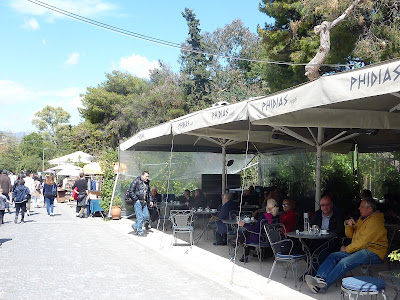

















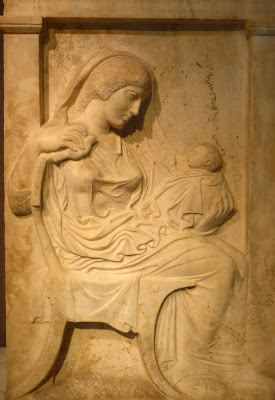

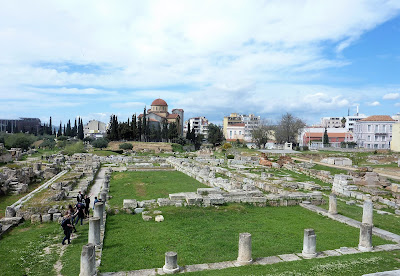







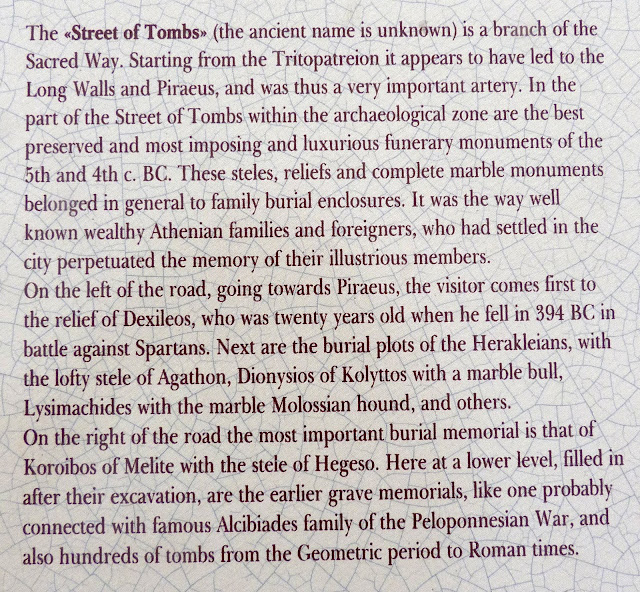
















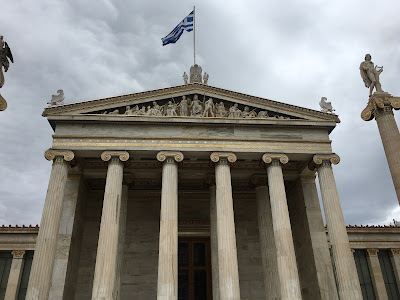







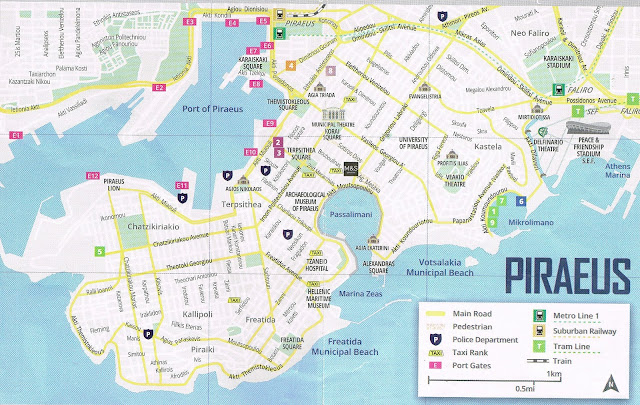
Reacties
Een reactie posten